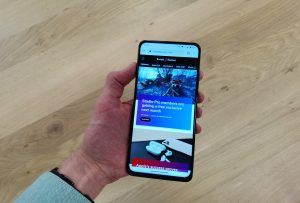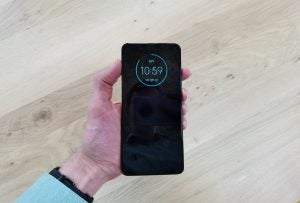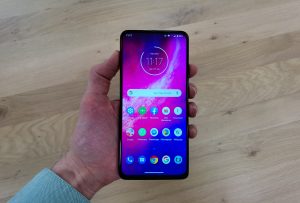Motorola One Hyper Review
Motorola One Hyper Review
Very solid

Verdict
A very strong all-round smartphone for a reasonable price – this a a good choice if you prioritise a long-lasting battery and a good screen.
Pros
- Nice screen
- Enduring battery life
- Speedy charging
- Clean software
- Good main camera
Cons
- Middling processor
- Poor ultrawide camera
- Poor call quality
Key Specifications
- Review Price: £269.99
- 161.8 x 76.6 x 8.9mm
- 210g
- 6.5-inch, 1080 x 2340p LCD display
- Android 10 (Android One)
- Snapdragon 675 chipset
- 4GB RAM
- 128GB storage
- 64-megapixel main camera
- 8-megapixel ultrawide camera
- 32-megapixel pop-up selfie camera
- 4000mAh battery
The Motorola One Hyper is the brand’s latest mid-range phone in its Android One series, which aims to offer clean software and long-term support with good-value hardware at a modest price.
Most other devices in the series have an obvious key selling point, with the Motorola One Action providing a GoPro-like action camera and the Motorola One Zoom packing a 3x telephoto zoom. It’s hard to see what the name “Hyper” is supposed to evoke, other than a children’s birthday party fuelled by a load of sugar, but the headline specs here include a 64-megapixel main camera sensor, a 4000mAh battery equipped with fast-charging, and a high-quality screen.
Design
- An eye-catching mid-ranger
The Motorola One Hyper is available in two colours – ‘Fresh Orchid’, which a purple hue, and ‘Deep Sea Blue’, which is the bluish-turquoise colour of our review device.

Motorola One Hyper rear panel
It’s a firmly mid-range smartphone, so you can’t expect a high-end glass-and-aluminium construction; the back panel and the frame is made of plastic, and it feels it. Nonetheless, it’s got a shiny finish and an understated stripe that lines up with the dual camera, with the rear fingerprint scanner mounted in the middle of the device.
As with many handsets, this one picks up smears fairly easily. I found its appearance unremarkable, but it did receive a couple of compliments from friends who admired the shimmering finish.
One design aspect of the phone which I did appreciate – and again, did cause people to take notice – is the pop-up camera, which ensures a notch-free display. The selfie snapper rises from the top of the phone fairly promptly when you tap the icon in the camera app.

Motorola One Hyper lock screen
Taking a look at the more practical aspects, the inclusion of the 3.5mm headphone jack and the option for expandable storage via SD card (up to 1TB) are both much appreciated in an era where flagship phones are doing away with such things, and additionally the phone supports NFC for making contactless payments.
The device offers just a rear-mounted fingerprint scanner rather than an in-screen option or face unlock, and neither of these losses would affect me in theory – they’re more convenient for sure, but their absence is hardly a deal-breaker, especially in the reasonably priced segment of the market. However, I found this fingerprint scanner to be a little unreliable, either requiring a few attempts or failing to unlock and forcing me to tap in my PIN instead, which was somewhat irritating.
The power button (which has a textured finish) is one the same side as the volume control toggle, and I found I needed two hands in order to take a screenshot.
Overall it’s still a good functional design, with a notch solution that’s bound to be a major attraction to those wanting an uncompromised full screen experience.
Screen
- A notch-free, sharp LCD
The Hyper’s LCD screen measures 6.5-inches diagonally and has a 1080 x 2340 resolution. The aforementioned lack of a notch means you get the uninterrupted full-screen experience, and the slim bezels that surround the screen are by no means chunky enough to detract from your immersion.
The display is sharp, with text appearing crisp, and colours bright (albeit not with HDR enhancement for the ‘popping’ effect you get from some expensive handsets).
It’s not an OLED, so you won’t get pitch black tones but I was not at all disappointed when watching video content or scrolling through the browser. Bearing in mind that plenty of phones at this price point still opt for a 720p resolution as a cost-cutting measure, this display certainly emerges as a recommending factor for this phone compared to its peers.

Motorola One Hyper browser
One very minor niggle was the reliability of the reactive brightness setting, which sometimes dimmed inappropriately in darker settings – a little irritating but hardly a deal-breaker as you can easily switch off this mode in the Settings app. When the device is on standby, it displays the time and battery capacity along with notification symbols when it’s moved, but otherwise rests on a black screen rather than having an always-on display.

Motorola One Hyper standby screen
The sharp, fairly big display is a good reason to choose this phone over similarly-priced handsets – if you regularly watch videos on the go, this would be a good-value choice.
Performance
- Not a powerhouse, but enough for most people
The Hyper’s chipset is the Snapdragon 675, and it remains one of the least impressive entries on its specs sheet. Released in October 2018, it’s a firmly mid-range proposition that probably won’t be the right fit for you if you’re a power user who makes high demands of their smartphone when it comes to playing games or video editing. The Hyper pairs it’s modest chipset with 4GB of RAM.
Below is a table of how the performance scores stack up next to another Android One mid-ranger, the Xiaomi Mi A3, to which it compares favourably.
(Note: Geekbench 5 measures CPU performance, 3D Mark measures gaming performance, and Antutu measures overall performance)
| Geekbench 5 Single Core | Geekbench 5 Multi Core | Antutu Benchmark | 3D Mark Slingshot Extreme | |
| Motorola One Hyper | 502 | 1584 | 215104 | 1167 |
| Xiaomi Mi A3 | 307 | 1269 | 179088 | 1137 |
In everyday use I found that this device got the job done, albeit occasionally there were stutters or slight delays when I was multitasking (a habit encouraged by the Android 10 user interface). A couple of times apps shut down unexpectedly (the guilty parties being Facebook and The Economist), but generally I found that apps ran well. It was mostly smooth when switching between tabs even if I’d had them open for a while. When running a very demanding app (namely Asphalt 9), graphics at the default setting were adequate though not super sharp, and I didn’t notice any lag.
If you’re a power user hoping to get your fix on a budget, there are better options available (take a look at the Snapdragon 710-toting Realme 3 Pro for instance) – but if you just use your smartphone for relatively simple everyday tasks, the Hyper should be up to the job.
Software
- Android One continues to impress
The Motorola One Hyper is a member of the Android One programme (alluded to by the “One” moniker), which means that it’s one of the first in line for software updates from Google. It’s got guaranteed operating system updates for two years and security updates for three.
This might not seem altogether impressive compared to Apple’s long-term support, but does represent significant improvement with regard to Android mid-rangers (which can otherwise be forgotten by manufacturers shortly after launch).

Motorola One Hyper homescreen
Thanks to this arrangement, the device runs the latest Android 10 software with a minimalist philosophy – the software is the full-fat operating system run by other smartphones, but gone is the unnecessary bloatware that some Android manufacturers are prone to packing their devices with, so instead you’ll get little more than the traditional Google suite of apps. In my opinion this is a boon for performance and functionality.
By default the Hyper employs uses the gesture system introduced by Android 10 which can take some people a little while to get used to, but you can switch to the traditional three-button system in the settings if you wish.
The stripped-down, straightforward software experience offered by this smartphone is ideal. It’s a good example of Android done right.
Camera
- A decent main camera but the ultra-wide is a bit of a let down
The camera is a dual-lens set-up, consisting of a 64-megapixel main sensor and an 8-megapixel ultra-wide snapper. Motorola has been keen to advertise the former, and a bit more reticent when it comes to the latter, and there’s a reason for that.

Motorola One Hyper main camera
The main lens performs well, giving images that are strong on detail and nicely balanced.

Motorola One Hyper main camera
Results generally look fairly pleasing without being over-processed, with tones remaining natural. Hence this overcast view down the Thames is faithfully reproduced rather than overcompensated for by leery, enhanced colours.
Main camera with Night Vision off (left) and on (right)
Low-light performance is also pretty good: Night Vision software mode does reduce noise a smidgen and bring out deeper colours, but even when this mode isn’t turned on, the result is still respectable.
Main camera (left), ultra-wide camera (right)
However, switch to the ultra-wide and unfortunately you’ll find lower-quality, distorted images. The comparison image of the building above is a good example of the drop-off in quality, showing good levels of detail and warm colour representation from the main camera, while the ultra-wide results are distorted, less sharp, and duller. Frankly, I’d have preferred the device to have stuck to just one lens and passed on the saving in a lower price rather than include this underwhelming ultra-wide.

Motorola One Hyper selfie camera
The selfie camera has an unusually high 32-megapixel resolution. The resulting images have good levels of detail when it comes to hair for example, again escaping the over-processed look that is often even more pronounced on the front-facing snapper.
Battery life
- More than enough juice for a heavy day’s use
With a capacity clocking in at 4000mAh, the battery is one of the Hyper’s leading recommending factors, even beating out Android flagships such as the Samsung Galaxy S10 (3400mAh). Bearing in mind its less demanding screen and internals next to such devices, I was expecting a strong showing – and I wasn’t disappointed.
Given a long day (7am to 11pm) of fairly heavy usage, where the device entertained me with podcasts and magazines through a lengthy commute both ways, played music at my desk, and showed videos on my lunch break before a spot of gaming in the evening, the battery tended to be reduced to around 35% from full.
After a weekday night out with friends on top of the daily drudge, there was still easily enough charge that I could comfortably summon an Uber for the journey home after the last possible public transport had long since gone.
Of course, on this level of use, you won’t be able to make the phone last for two days straight, as the manufacturer claims – but if you’re a fairly modest user then that’s not too far-fetched.
Fortunately, it’s also got impressive form when it comes to charging, thanks to the 27W Turbo Charger supplied in the box. Judging from the scores recorded below, you’ll easily get a day’s charge after half an hour of charging, which is ideal if you’ve forgotten to charge your phone overnight. The device doesn’t support wireless charging, but that’s to be expected at this price point and I didn’t find that to be an inconvenience at all.
| Time | Battery percentage |
| 0 minutes | 31% |
| 16 minutes | 69% |
| 21 minutes | 78% |
| 39 minutes | 96% |
The battery is certainly one of the most impressive features of this device – not only is it beefy enough to easily see you through a full day of heavy use with no issues whatsoever, but it recharges speedily too. If you opt for this phone, you won’t be worried about it dying on you when you most need it.
Audio
- A headphone jack and decent speaker, but below par call quality
The Hyper has two small speakers – a tiny one just above the screen and another on the base of the phone, while the 3.5mm audio port is also present on the top of the device.
The inclusion of the headphone jack is always a positive – audio quality is better through wired headphones and it’s always to easy to pick up a cheap pair of earbuds at an airport or train station if you’ve forgotten yours, and pallor at the prospect of a long journey without audio entertainment.
If you like to go wireless, it was very quick and straightforward to pair the device with Bluetooth headphones, and it reconnected promptly and reliably as well.
The speakers were loud and clear, and moreover, the haptic vibration feedback was also notably strong, so you won’t fear missing out on a pressing notification.
However, I must admit that the call quality on this handset was a real disappointment. I struggled to hear what people on the other end of the line were saying, as their voices sounded faint and muffled. While more and more people are using messaging apps to communicate, call quality should still be a fundamental feature for any device that calls itself a phone.
Should you buy the Motorola One Hyper?
This is a good smartphone at a reasonable price, so if you’re looking for an all-round performer that doesn’t break the bank then this is a good bet. The screen is high quality, the main camera is good and the battery life is excellent – three very big ticks on most wishlists. But there are a couple of things that hold me back from giving this device my full-throated enthusiasm.
The shortcomings of the ultra-wide lens mean that this device doesn’t offer the versatility provided by some competitors, and there are better processors around for less money too – but a more disappointing shortcoming is the poor call quality, which could be a real source of frustration if phone calls are your preferred method of communication over messaging apps, emails, or texts.
Verdict
Overall this is a good all-round device that offers a strong showing in key areas such as camera, battery, screen, and software. It’s held back by some slightly underwhelming factors (such as an inconsistent fingerprint scanner, poor call quality, a poor ultra-wide camera) that stop it from being recommended by reflex, but nonetheless it stands out as a very solid mid-range performer.
How we test phones
We test every mobile phone we review thoroughly. We use industry standard tests to compare features properly and we use the phone as our main device over the review period. We’ll always tell you what we find and we never, ever, accept money to review a product.


